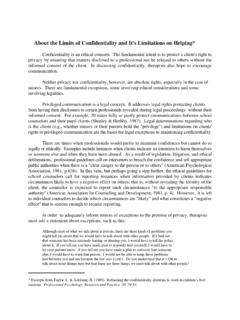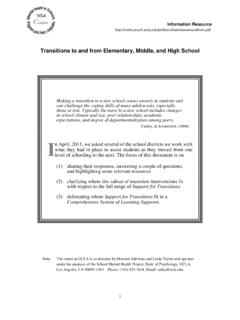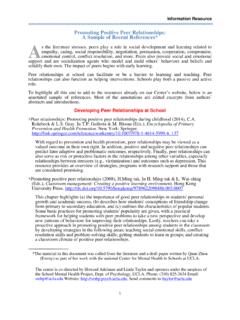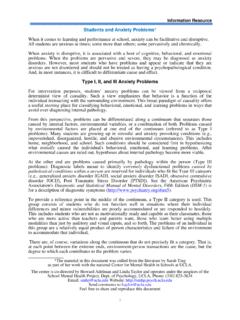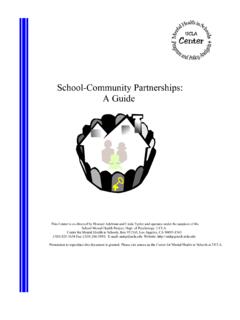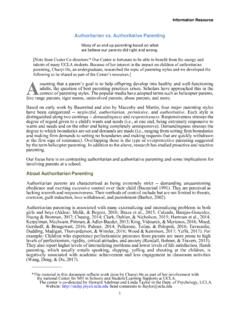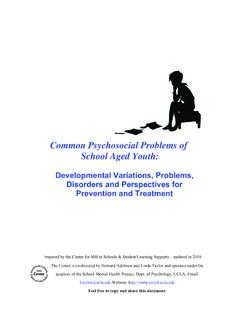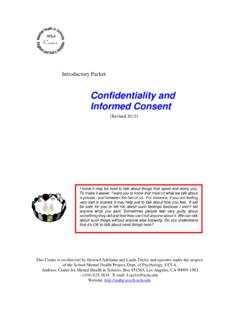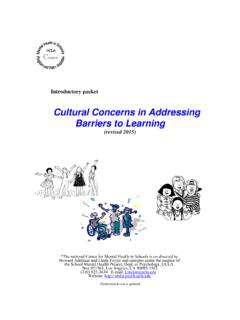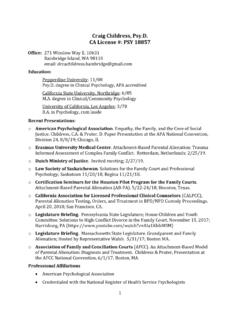Transcription of About Physical and Mental Health Effects of Racism and ...
1 1 Research NotesAbout Physical and Mental Health Effects of Racism and Discrimination on African Americans Note: Maya Omuziligbo, an undergraduate working with our Center at UCLA, indicated her interest inreviewing literature on the impact of Racism on African American s Physical and Mental Health . Thefollowing set of Research Notes is an edited version of her brief of Racism abound as do views About the nature and scope of its negative impact onindividuals, groups, and society (see reference section). As Harrell (2000) states:[We] must embrace the challenge of understanding the nature of Racism -related stress and disentangling the complex relationships between Racism andwell-being.. the primary question is not whether Racism affects people ofcolor, nor does it involve comparing the importance of Racism to theimportance of other variables. Rather, the central question involves thecomplexity of the ways in which Racism influences the well-being ofoppressed racial/ethnic groups and their members.
2 With respect to well-being, Physical and Mental Health are areas of particular concern. To highlightthe literature on these topics, this resource focuses mainly on African Americans experience andperceptions of Racism and discrimination as related to symptoms of hypertension and post traumaticstress. Racism and the Biopsychosocial model of Health and IllnessRacism is a complex, institutionalized phenomena. In exploring its impact, it is essential toremember that race intersects with class, gender, age, sexuality, nationality, and other variables (seeCenter for Mental Health in Schools, 2016).Given that behavior is reciprocally determined, it is reasonable to consider Health and illness interms of the transactions of person variables ( , genetic inheritance, cognitive and socialdevelopment, attitudes, differences in current motivation and capability, disabilities) andenvironment variables ( , societal, cultural, neighborhood, family, peers, school).
3 A considerablebody of research has encapsulated reciprocal determinism into a biopsychosocial model with anemphasis on stress and coping. In doing so, efforts have been made to determine how muchinfluence various factors and their transactions have in the development of problems such ashypertension and post traumatic stress disorder (PTSD). Racism , Discrimination, and Hypertension Interpersonal and institutionalized Racism and discrimination are widely viewed as stressors thatcan affect Health . For example, they contribute to events and living conditions in which poverty,crime, and violence are persistent sources of stress. Racism and discrimination are seen as leadingto an internalization of stereotypes and denigrating images in ways that adversely affect feelings ofself-worth and undermine Physical well-being and social and psychological on existing research, the general view is that institutional discrimination can lead groupmembers to accept and/or internalize the larger society's negative characterization of their group,and the internalization of society s negative beliefs can adversely affect individual s Health .
4 High levels of blood pressure ( , hypertension) are a prominent concern for a subgroup of AfricanAmericans. The problem is compounded for them when access to proper Health care is impeded. *The material in this document reflects work done by Maya Omuziligbo as part of her involvement with the national Center for Mental Health in Schools at UCLA. The center is co-directed by Howard Adelman and Linda Taylor in the Dept. of Psychology, UCLA, Website: Send comments to 2 Rates of hypertension have declined in recent years, Available data indicate that 70 millionAmerican adults (29%) currently have high blood pressure. For African Americans and MexicanAmericans the respective rates are About 44% and 28%. African Americans develop high bloodpressure at an earlier age than whites and Hispanics. Among African Americans, more women( ) than men ( ) have high blood pressure. As a review of mainstream research indicates,institutional Racism and discrimination are viewed as playing significant roles in the problem.
5 Negative Effects on Blood Pressure of Internalized Oppression A review by Williams and Neighbors (2001) suggests that the differential exposureby race to the chronic strain of perceived discrimination can contribute to theincreased rate of hypertension among African Americans. A study by Peters (2004)examined the prevalence of perceived Racism and its effect on African American'sblood pressure and development of hypertension. The study reported that AfricanAmerican women and men who had low experiences of Racism and who typicallyaccepted unfair treatment tended to have higher blood pressure than those whochallenged unfair treatment. Peters suggests that the internalized oppression that isdeveloped by some African Americans results in unfair treatment being perceivedas deserved and not discriminatory." Hill and colleagues (2007) studied a sample of African American college reporting higher levels of perceived Racism exhibited higher levels of daytimeand nighttime diastolic blood pressure.
6 The researchers concluded that perceptionsof Racism are a particularly salient social stressor among African Americans andcontribute to stress-induced blood pressure elevation. Post-Traumatic Stress Disorder, Racism , and DiscriminationConstantly experiencing highly stressful events is a recipe for producing symptoms of and colleagues (2011) report the lifetime prevalence of PTSD as highest among Blacks( ), intermediate among Hispanics and Whites ( and ) and lowest among Asians( ). The National Survey of American Life (NSAL) reported a PTSD prevalence rate of African Americans as contrasted with in non-Hispanic Whites (Himle et al., 2009).Increasing rates also have been reported for Hispanic Americans, Native Americans, Pacific IslanderAmericans. and Southeast Asian refugees (Chou, Asnaani, & Hofmann, 2012; Pole, et al., 2008).Bruce, et al. (2007) report findings that ethnic identity moderated PTSD symptoms in response toperceived Racism , such that there was a higher amount of PTSD symptoms seen in those who hada higher ethnic identity.
7 According to SAMHSA (Substance Abuse and Mental Health Services Administration) individualtrauma results from an event, series of events, or set of circumstances that is experienced by anindividual as physically or emotionally harmful or life threatening and that has lasting adverseeffects on the individual s functioning and Mental , Physical , social, emotional, or spiritual well-being. Traumatic Effects may be acute or chronic. They may be manifested in a variety of ways, such asanxiety, shock, denial, heightened arousal, difficulty concentrating, confusion, sadness, fear, guilt,shame, self-blame, hopelessness, withdrawal, feeling disconnected or numb, disturbed sleep,difficulty paying attention, anger, irritability, reactivity, repeated and intrusive thoughts, depression,mood swings, and a variety of behavioral, academic, and interpersonal problems. A cluster of suchreactions often are diagnosed as Post Traumatic Stress Disorder (PTSD).3At the same time, it is important to remember that not everyone who encounters a traumaticexperience develops PTSD.
8 People can be resilient. Many develop inner strengths and defenses thathelp them cope effectively with toxic events; others benefit from external protective buffers suchas various forms of social general, the type and the intensity of exposure to stressful events and living conditions are relatedto developing PTSD. With respect to Racism and discrimination, these appear to contribute to thedevelopment of PTSD when they intersect with other risk factors and when protective factors arenot present or cannot counter is not an event itself, but rather a response to one or more overwhelminglystressful events where one s ability to cope is dramatically undermined. Theseexperiences in childhood can lead to a cascade of social, emotional and academicdifficulties. As students get older, exposure to traumatic experiences can also leadto the adoption of self-medicating behaviors such as substance abuse, smoking,and overeating. All of these responses to traumatic events can interfere with achild s ability to learn at Trauma and Learning Policy InitiativeIn another resource, our center highlights current literature on addressing problems related to traumain schools and clarifies why the focus needs to go well beyond clinically-oriented Mental healthinterventions (Center for Mental Health in Schools.)
9 2015).Concluding Comments Racism and discrimination can be perpetrated, intentionally or unintentionally, byinstitutions or individuals. An African American s perceptions of Racism and discriminationcan contribute to his/her development of Health problems such as hypertension, PTSD, andproblems at school and work. Future research on the impact of Racism should differentiate subgroups of African Americansin terms of factors such as class, race, gender, age, country of origin and time in the andstudy intersections of such factors. Research also needs to clarify potential as Shelly Harrell (2000) cautions: Consideration of Racism as a source of stress should not be used inappropriately topathologize the functioning of historically nondominant racial/ethnic groups. It isessential both to avoid a blame the victim posture, which holds individuals solelyresponsible for their condition, and to resist promoting the idea that Racism cansimply be ignored, without psychological consequence.
10 The identification ofsuccessful people of color has been used to minimize the role of Racism in Americansociety, as well as to attribute deviance to those who are unsuccessful in economicor employment domains. However, recent data have revealed the social andpsychological costs of success for people of color, and the everpresent reality ofracism in the lives of the successful (references in the orginal). Discussions of Racism in the public domain often include assertions that historicallyoppressed peoples lack personal responsibility, frequently and inappropriately play the race card, or readily adopt a victim role. These beliefs limit the creative explorationof solutions; impose the perceptions of outsiders on the experience of the affectedindividuals; label, judge, disrespect, and devalue the life experience of other humanbeings; and, ultimately, fail to allow for the healing and growth of individuals, families,and communities.
